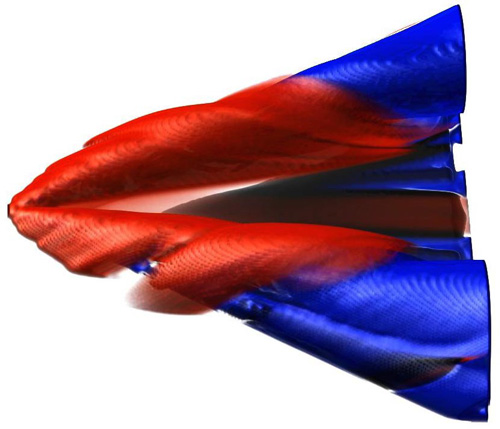Galileo Galilei (15 February 1564 -- 8 January 1642) has been credited with fundamental improvements to early telescope designs that resulted in the first practically usable instrument for observing the heavens. With his “invention,” Galileo went on to many notable astronomical discoveries: the satellites of Jupiter, sunspots and the rotation of the sun, and proved the Copernican heliocentric model of the solar system (where the sun, rather than the earth, is the center of the solar system). These discoveries, and their subsequent impact on science and society, would not have been possible without the aid of the telescope – a device that serves to transform the unseeable into the seeable.
Modern scientific visualization, or just visualization for the sake of brevity in this article, plays a similarly significant role in contemporary science. Visualization is the transformation of abstract data, whether it be observed, simulated, or both, into readily comprehensible images. Like the telescope and other modern instruments, visualization has proven to be an indispensable part of the scientific discovery process in virtually all fields of study. It is largely accepted that the term “scientific visualization” was coined in the landmark 1987 report1 that offered a glimpse into the important role visualization could play in scientific discovery.
Visualization produces a rich and diverse set of output – from the x/y plot to photorealistic renderings of complex multidimensional phenomena. It is most typically “reduced to practice” in the form of software. There is a strong, vibrant, and productive worldwide visualization community that is inclusive of commercial, government and academic interests.
The field of visualization is as diverse as the number of different scientific domains to which it can be applied. Visualization software design and engineering both study and solve what are essentially computer science problems. Much of visualization algorithm conception and design shares space with applied mathematics. Application of visualization concepts (and software) to specific scientific problems to produce insightful and useful images overlaps with cognitive psychology, art, and often the scientific domain itself.

In the present day, the U.S. Department of Energy has a significant investment in many science programs. Some of these programs, carried out under the Scientific Discovery through Advanced Computing (SciDAC) program,3 aim to study, via simulation, scientific phenomena on the world’s largest computer systems. These new scientific simulations, which are being carried out on fractional-petascale sized machines today, generate vast amounts of output data. Managing and gaining insight from such data is widely accepted as one of the bottlenecks in contemporary science.4 As a result, DOE’s SciDAC program includes efforts aimed at addressing data management and knowledge discovery to complement the computational science efforts.
The focus of this article is on how one group of researchers – the DOE SciDAC Visualization and Analytics Center for Enabling Technologies (VACET) – is tackling the daunting task of enabling knowledge discovery through visualization and analytics on some of the world’s largest and most complex datasets and on some of the world's largest computational platforms. As a Center for Enabling Technology, VACET’s mission is the creation of usable, production-quality visualization and knowledge discovery software infrastructure that runs on large, parallel computer systems at DOE's Open Computing facilities, and that provides solutions to challenging visual data exploration and knowledge discovery needs of modern science, particularly the DOE science community.






